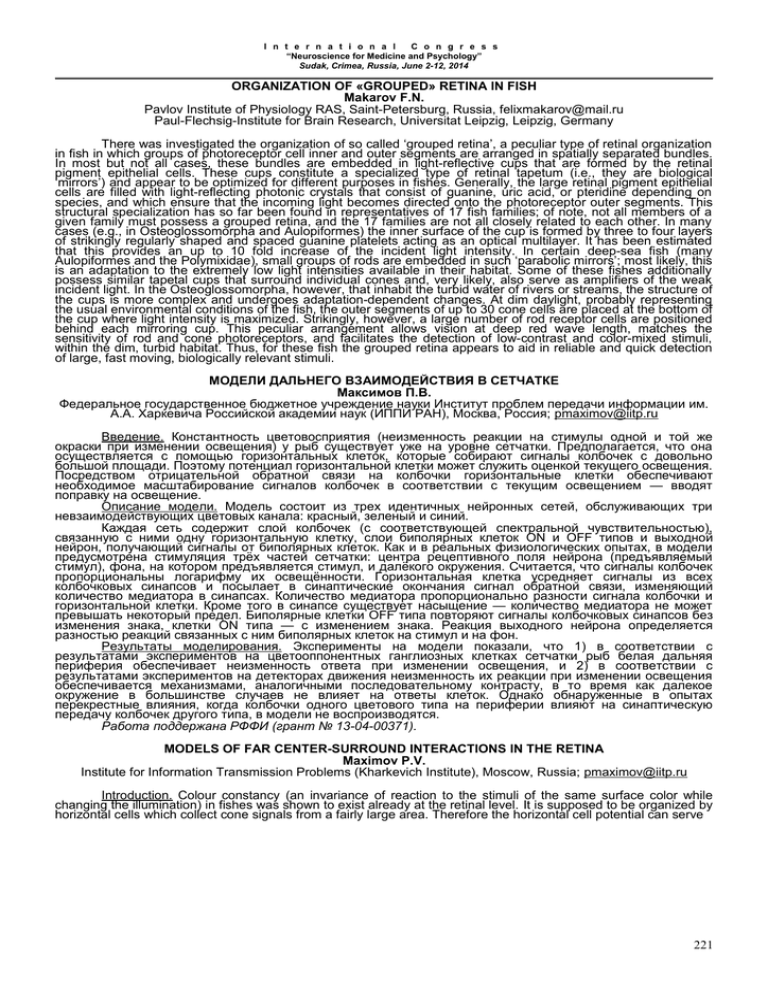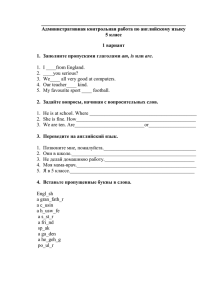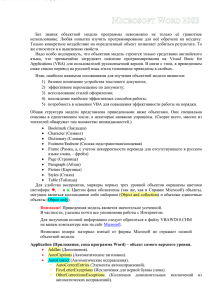ORGANIZATION OF «GROUPED» RETINA IN FISH Makarov F.N.
advertisement

I n t e r n a t i o n a l C o n g r e s s “Neuroscience for Medicine and Psychology” Sudak, Crimea, Russia, June 2-12, 2014 ORGANIZATION OF «GROUPED» RETINA IN FISH Makarov F.N. Pavlov Institute of Physiology RAS, Saint-Petersburg, Russia, felixmakarov@mail.ru Paul-Flechsig-Institute for Brain Research, Universitat Leipzig, Leipzig, Germany There was investigated the organization of so called ‘grouped retina’, a peculiar type of retinal organization in fish in which groups of photoreceptor cell inner and outer segments are arranged in spatially separated bundles. In most but not all cases, these bundles are embedded in light-reflective cups that are formed by the retinal pigment epithelial cells. These cups constitute a specialized type of retinal tapetum (i.e., they are biological ‘mirrors’) and appear to be optimized for different purposes in fishes. Generally, the large retinal pigment epithelial cells are filled with light-reflecting photonic crystals that consist of guanine, uric acid, or pteridine depending on species, and which ensure that the incoming light becomes directed onto the photoreceptor outer segments. This structural specialization has so far been found in representatives of 17 fish families; of note, not all members of a given family must possess a grouped retina, and the 17 families are not all closely related to each other. In many cases (e.g., in Osteoglossomorpha and Aulopiformes) the inner surface of the cup is formed by three to four layers of strikingly regularly shaped and spaced guanine platelets acting as an optical multilayer. It has been estimated that this provides an up to 10 fold increase of the incident light intensity. In certain deep-sea fish (many Aulopiformes and the Polymixidae), small groups of rods are embedded in such ‘parabolic mirrors’; most likely, this is an adaptation to the extremely low light intensities available in their habitat. Some of these fishes additionally possess similar tapetal cups that surround individual cones and, very likely, also serve as amplifiers of the weak incident light. In the Osteoglossomorpha, however, that inhabit the turbid water of rivers or streams, the structure of the cups is more complex and undergoes adaptation-dependent changes. At dim daylight, probably representing the usual environmental conditions of the fish, the outer segments of up to 30 cone cells are placed at the bottom of the cup where light intensity is maximized. Strikingly, however, a large number of rod receptor cells are positioned behind each mirroring cup. This peculiar arrangement allows vision at deep red wave length, matches the sensitivity of rod and cone photoreceptors, and facilitates the detection of low-contrast and color-mixed stimuli, within the dim, turbid habitat. Thus, for these fish the grouped retina appears to aid in reliable and quick detection of large, fast moving, biologically relevant stimuli. МОДЕЛИ ДАЛЬНЕГО ВЗАИМОДЕЙСТВИЯ В СЕТЧАТКЕ Максимов П.В. Федеральное государственное бюджетное учреждение науки Институт проблем передачи информации им. А.А. Харкевича Российской академии наук (ИППИ РАН), Москва, Россия; pmaximov@iitp.ru Введение. Константность цветовосприятия (неизменность реакции на стимулы одной и той же окраски при изменении освещения) у рыб существует уже на уровне сетчатки. Предполагается, что она осуществляется с помощью горизонтальных клеток, которые собирают сигналы колбочек с довольно большой площади. Поэтому потенциал горизонтальной клетки может служить оценкой текущего освещения. Посредством отрицательной обратной связи на колбочки горизонтальные клетки обеспечивают необходимое масштабирование сигналов колбочек в соответствии с текущим освещением — вводят поправку на освещение. Описание модели. Модель состоит из трех идентичных нейронных сетей, обслуживающих три невзаимодействующих цветовых канала: красный, зеленый и синий. Каждая сеть содержит слой колбочек (с соответствующей спектральной чувствительностью), связанную с ними одну горизонтальную клетку, слои биполярных клеток ON и OFF типов и выходной нейрон, получающий сигналы от биполярных клеток. Как и в реальных физиологических опытах, в модели предусмотрена стимуляция трёх частей сетчатки: центра рецептивного поля нейрона (предъявляемый стимул), фона, на котором предъявляется стимул, и далёкого окружения. Считается, что сигналы колбочек пропорциональны логарифму их освещённости. Горизонтальная клетка усредняет сигналы из всех колбочковых синапсов и посылает в синаптические окончания сигнал обратной связи, изменяющий количество медиатора в синапсах. Количество медиатора пропорционально разности сигнала колбочки и горизонтальной клетки. Кроме того в синапсе существует насыщение — количество медиатора не может превышать некоторый предел. Биполярные клетки OFF типа повторяют сигналы колбочковых синапсов без изменения знака, клетки ON типа — с изменением знака. Реакция выходного нейрона определяется разностью реакций связанных с ним биполярных клеток на стимул и на фон. Результаты моделирования. Эксперименты на модели показали, что 1) в соответствии с результатами экспериментов на цветооппонентных ганглиозных клетках сетчатки рыб белая дальняя периферия обеспечивает неизменность ответа при изменении освещения, и 2) в соответствии с результатами экспериментов на детекторах движения неизменность их реакции при изменении освещения обеспечивается механизмами, аналогичными последовательному контрасту, в то время как далекое окружение в большинстве случаев не влияет на ответы клеток. Однако обнаруженные в опытах перекрестные влияния, когда колбочки одного цветового типа на периферии влияют на синаптическую передачу колбочек другого типа, в модели не воспроизводятся. Работа поддержана РФФИ (грант № 13-04-00371). MODELS OF FAR CENTER-SURROUND INTERACTIONS IN THE RETINA Maximov P.V. Institute for Information Transmission Problems (Kharkevich Institute), Moscow, Russia; pmaximov@iitp.ru Introduction. Colour constancy (an invariance of reaction to the stimuli of the same surface color while changing the illumination) in fishes was shown to exist already at the retinal level. It is supposed to be organized by horizontal cells which collect cone signals from a fairly large area. Therefore the horizontal cell potential can serve 221 I n t e r n a t i o n a l C o n g r e s s “Neuroscience for Medicine and Psychology” Sudak, Crimea, Russia, June 2-12, 2014 as an estimate of the current ambient illumination. By the use of the negative feedback to cones, horizontal cells provide necessary scaling for the cone signals according to the current illumination – in other words they discount the illumination. Model description. The model consists of three identical neural networks, serving three non-interacting color channels: red, green and blue. Each network contains the cone layer (with cones of the appropriate spectral sensitivity), one horizontal cell connected with all the cones, layers of ON– and OFF– bipolar cells and an output neuron which receives signals from bipolar cells. As in real physiological experiments three parts of the retina can be stimulated in the model: the receptive field center (the presented stimulus itself), the background, where the stimulus appears, and the far surround. Cone signals are considered to be proportional to the logarithm of their illumination. The horizontal cell averages signals from all cone synapses and sends the feedback signal to the cone pedicles, which changes the transmitter quantity in the synapses. The transmitter quantity in the model is made proportional to the difference between the cone and horizontal cell signals. Besides that there is saturation in the synapse: the transmitter quantity can not exceed some limit. Bipolar cells of the OFF type repeat signals of cone synapses in a sign-conserving way, whereas those of ON type do it in a sign-inverting way. A response of the output neuron is determined by the difference of signals of associated bipolar cells to a stimulus and background. Results of simulation. Experiments on the model showed that 1) in accordance with the results of experiments on colour-opponent ganglion cells of the fish retina a white far surround provides an invariance of response when lighting conditions change, and 2) in accordance with the results of experiments on motion detectors an invariance of their responses under changes of illumination is provided by a mechanism similar to successive contrast, while the far surround in most cases does not affect the response of the cells. However, the crosstalk influences observed in the experiments, when cones of one colour type at the periphery affect synaptic transmission from cones of another chromatic type are not reproduced in the model. Supported by the RFBR grant 13-04-00371. ОСОБЕННОСТИ ФУНКЦИОНАЛЬНОЙ ОРГАНИЗАЦИИ ТЕЛА НА КАЖДОМ ИЗ УРОВНЕЙ ПОСТРОЕНИЯ ДВИЖЕНИЙ Н.А.БЕРНШТЕЙНА Максимова Е.В. Государственное бюджетное образовательное учреждение города Москвы центр лечебной педагогики и дифференцированного обучения "Наш дом", Москва, Россия, elena@maximova.org Н. А. Бернштейн описал следующие уровни построения движений: А – уровень палеокинетических регуляций – тонус, активность, поза и удержание напряжения тела; В – уровень синергий и штампов – содержит в себе набор врожденных и приобретенных двигательных автоматизмов тела; С – уровень пространственного поля – восприятие и достижение реальных целей в реальном пространстве; D – уровень действий – восприятие и достижение представляемых целей в представляемом пространстве; группа уровней Е – уровни интеллектуального регулирования действий. Кроме того, нами был описан, как еще один уровень построения тела – уровень V – соответствующий автономной нервной системе. При работе методами телесно ориентированной терапии – нами были выявлены особенности функциональной организации тела (сборки тела) по каждому из уровней построения движений. Причем особое значение мы придаем соединительной ткани – она не только объединяет тело, но формирует целостные функциональные мышечно-соединительнотканные связки, основы сборки тела по каждому уровню построения движений. (Майерс Т.В. Анатомические поезда, 2010) Для уровня А характерны – целостность (воздействие на глубокую чувствительность, при достаточной длительности, может распространиться на все тело) и прозрачность (нет препятствий для распространения волны тонического напряжения); все это очень напоминает сетчатую систему кишечнополостных – похоже, что эта система полностью сохранна и у человека; Уровень V – филогенетически соответствует червям; в теле человека сохраняется как мышечная выстилка внутри ребер и по внутренней части брюшной полости; мышечные сокращения от ануса носят волнообразный (червеобразный) характер; Уровень В – сборка тела, объединение десятков и сотен мышц в единые мышечные ансамбли, идет с опорой на большие диагонали, например при ходьбе – плечо, таз, колено, стопа; тонус, осознанное чувствование себя практически не значимы – только как изменения напряжения при реципрокности; Уровень С – сборка тела строится от точки Центрирования – сплетения, расположенного чуть выше лобковой кости (схема очень похожа на Головонога, которого рисуют маленькие дети); осознанное чувствование и контроль движений; контролируемые части наполнены тонусом; Уровень D – основные свойства тела – легкость, текучесть – почти нет тонического напряжения; при активации Dтела значима текучая (жидкостная) составляющая соединительнотканного объединения тела; Е – пока самый загадочный для нас уровень; на настоящий момент обнаружено, что при активации Е уровня (например, во время исполнения музыкального произведения) происходит целостное наполнение тела энергией. FEATURES OF BODY COMPILATION AT EACH LEVEL OF N.A. BERNSTEIN'S MOVEMENTS CONSTRICTION Maximova E.V. State Educational Institution of Moscow city center curative education and differentiated instruction "Our House", Moscow, Russia, elena@maximova.org N. A. Bernstein described the following levels of the movements construction: A – Paleokinetic regulation level – tonic regulation of the body as a whole: tonus, activity, posture and body tension containment, B – synergies and stamps level. It contains a set of congenital and acquired body motor automatisms, C – regional field level – perception and achieving of real goals in real space; D– action level – 222


